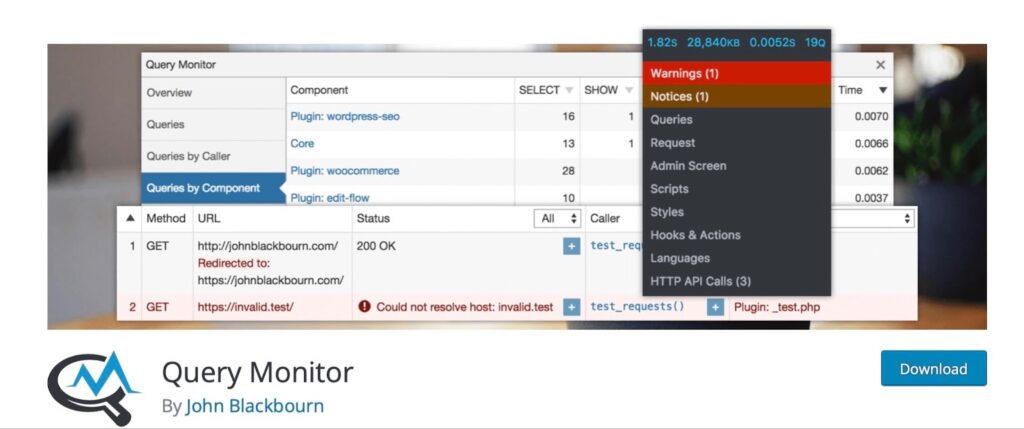WordPress, as a dynamic content management system, often requires meticulous performance tuning. P3 (Plugin Performance Profiler) was a popular tool for this purpose, but with its growing obsolescence, seeking alternatives has become imperative. This comprehensive guide explores four robust alternatives: UsageDD, WordPress Inspector, Debug Objects, and Query Monitor.
The Need for P3 Profiler Alternatives
WordPress Performance Challenges: WordPress sites can slow down due to plugin overloads or inefficient code. This sluggishness not only affects user experience but also SEO rankings.
The Demise of P3 Profiler: Once a go-to solution for diagnosing WordPress performance issues, P3 Profiler is now outdated and incompatible with the latest WordPress versions.
UsageDD: Simplifying Performance Analysis
UsageDD stands out for its simplicity and effectiveness in monitoring WordPress resource usage.
Key Features:
- Real-time resource tracking;
- Lightweight and unobtrusive.
Pros & Cons Comparison:
| Pros | Cons |
|---|---|
| Easy to install | Limited features |
| Minimal performance impact | Not detailed as others |
WordPress Inspector: Comprehensive Diagnosis

This tool provides an extensive analysis of your WordPress site’s health, performance, and security.
Key Features:
- Detailed performance reports;
- Security vulnerability checks.
User Experience Chart:
| Feature | User Satisfaction |
|---|---|
| Performance Analysis | High |
| Security Scanning | Medium |
Debug Objects: In-Depth Technical Insights
For developers, Debug Objects offers granular control over WordPress debugging.
Key Features:
- Deep-dive into WordPress hooks, actions, and filters;
- Query analysis and error logging.
Comparative Analysis with P3 Profiler:
- More detailed than P3 Profiler;
- Higher learning curve.
Query Monitor: The Ultimate Query Troubleshooter

Query Monitor is renowned for its detailed insights into WordPress queries, hooks, and conditions.
Key Features:
- Database query monitoring;
- Hook and action tracking.
Performance Impact Table:
| Feature | Impact Level |
|---|---|
| Query Monitoring | Moderate |
| Hook Tracking | Low |
Why Choose These Alternatives?
Each of these tools offers a unique balance. UsageDD and WordPress Inspector are user-friendly for non-technical users, while Debug Objects and Query Monitor cater to developers needing detailed insights. These tools are updated regularly, ensuring compatibility with the latest WordPress versions.
Integrating Drupal 7 Responsive Themes with WordPress Optimization
While exploring WordPress performance tools, it’s intriguing to consider how Drupal, another major CMS, approaches similar challenges, particularly through its responsive themes in Drupal 7.
Drupal 7, though older, still powers numerous websites. Its responsive themes ensure that sites adjust seamlessly to various device screens, enhancing user experience – a crucial factor in website performance.
List of Popular Drupal 7 Responsive Themes:
- Zen – Known for its flexibility and simplicity;
- Omega – Offers a grid-based layout for customization;
- Bootstrap – Based on the popular Bootstrap framework, ensuring mobile-first responsiveness.
Comparison Table: WordPress Optimization Tools vs. Drupal 7 Responsive Themes:
| Feature | WordPress Tools | Drupal 7 Themes |
|---|---|---|
| Performance Optimization | Advanced | Basic |
| User Experience Enhancement | Moderate | High |
| Technical Complexity | High (varies) | Moderate |
| Regular Updates | Yes | Limited |
Combining Strengths for Enhanced Performance
While WordPress and Drupal are distinct platforms, the principles of responsive design in Drupal 7 themes can inspire WordPress developers. Implementing responsive, lightweight themes can complement the performance enhancements offered by tools like UsageDD and Query Monitor.
Key Takeaways:
- Responsive design, as demonstrated by Drupal 7 themes, is vital for website performance;
- WordPress performance tools can be complemented by adopting principles of efficient, responsive design;
- Embracing cross-platform insights can lead to a more holistic approach to web performance optimization.
By acknowledging the strengths of Drupal 7’s responsive themes, WordPress site managers can gain a more rounded perspective on enhancing site performance, not just through backend optimization but also through front-end design choices.
Conclusion
In conclusion, while P3 Profiler served its purpose well, the evolving WordPress landscape necessitates more advanced solutions. UsageDD, WordPress Inspector, Debug Objects, and Query Monitor each offer distinct advantages, catering to a range of needs from basic monitoring to deep technical analysis.